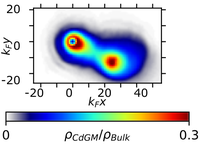Mutual friction and vortex Hall angle in a strongly interacting Fermi superfluid

Snapshot from the numerical simulation showing the population of Caroli–de Gennes–Matricon (CdGM) of two quantum vortices. Figure taken from arXiv:2503.21628.
N. Grani, D. Hernández-Rajkov, C. Daix, P. Pieri, M. Pini, P. Magierski, G. Wlazłowski, M.F. Fernández, F. Scazza, G. Del Pace, G. Roati
Mutual friction and vortex Hall angle in a strongly interacting Fermi superfluid,
[arXiv:2503.21628].
We study the two-dimensional motion of a vortex orbiting a pinned anti-vortex in a unitary Fermi superfluid across varying temperatures. By analyzing its trajectory, we extract the longitudinal and transverse mutual friction coefficients, which increase near the superfluid transition. These coefficients reveal the vortex Hall angle, which is linked to quasiparticle relaxation in Andreev-bound states and the transition to quantum turbulence. The experimental results are confronted with SLDA simulations, revealing good agreement. This work underscores the role of vortex-bound quasiparticles in vortex dynamics.
